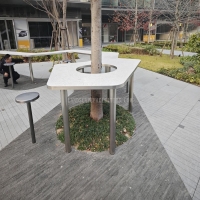Welcome to the website for landscape facilities products and knowledge.
How does the table’s design facilitate easy integration with room acoustics for better sound quality?
The relationship between furniture design and acoustic performance is often overlooked, yet it plays a crucial role in achieving optimal sound quality in any listening environment. Modern table designs incorporate specific features that actively work with room acoustics rather than against them, creating a more immersive audio experience.
One fundamental aspect is material selection. Tables constructed from dense, non-resonant materials like solid wood or specialized composites minimize unwanted vibrations that can color sound. These materials absorb rather than reflect acoustic energy, preventing the table surface from becoming a secondary sound source that interferes with direct audio from speakers. Advanced designs may incorporate constrained layer damping within the table structure, effectively dissipating vibrational energy before it can affect sound reproduction.
The strategic placement and integration of speakers within table designs represents another significant advancement. Rather than simply placing speakers on a table surface, which can cause comb filtering and phase issues, integrated designs position drivers at optimal heights and angles relative to the listener. Some innovative tables feature downward-firing woofers that use the table surface as a natural baffle, enhancing bass response while maintaining a clean aesthetic. The table's surface can be engineered to work as a wave guide, directing high frequencies precisely toward the listening position.
Table geometry and edge treatment significantly impact sound diffusion. Sharp, hard edges can create problematic reflections that reach the listener slightly delayed from the direct sound, causing acoustic comb filtering. Modern acoustic tables feature rounded edges, beveled designs, or integrated diffuser patterns that break up standing waves and scatter reflections harmlessly throughout the room. This approach transforms the table from a reflective obstacle into an acoustic treatment element.
Height-adjustable mechanisms in table design allow for precise speaker placement relative to room dimensions and listening position. The ability to fine-tune the height ensures that speakers interact optimally with room modes and reflection points. Some designs incorporate isolation platforms or decoupling systems that mechanically separate speakers from the table surface, preventing structure-borne vibrations from traveling through the furniture and affecting sound clarity.
For home theater configurations, tables may include cable management systems that not only organize wires but also prevent them from vibrating against surfaces, a subtle but meaningful source of acoustic distortion. Ventilation considerations in enclosed table designs ensure that speakers can breathe properly without port noise or cabinet resonance, maintaining driver performance at all volume levels.
The most sophisticated acoustic tables incorporate measurement and calibration systems. Using built-in microphones and processing capabilities, these smart tables analyze room response and automatically adjust speaker parameters or suggest optimal placement to compensate for room anomalies. This represents the ultimate integration of furniture design and acoustic science, where the table becomes an active participant in sound optimization rather than merely a platform for audio equipment.
Through these deliberate design choices, modern tables transcend their traditional role as simple furniture, becoming integral components in the pursuit of acoustic perfection. They demonstrate how thoughtful engineering can turn everyday objects into tools that enhance rather than compromise our listening experiences.
Related search:

Recommendation
An outdoor bar counter with stainless steel and terrazzo materials in an irregular shape